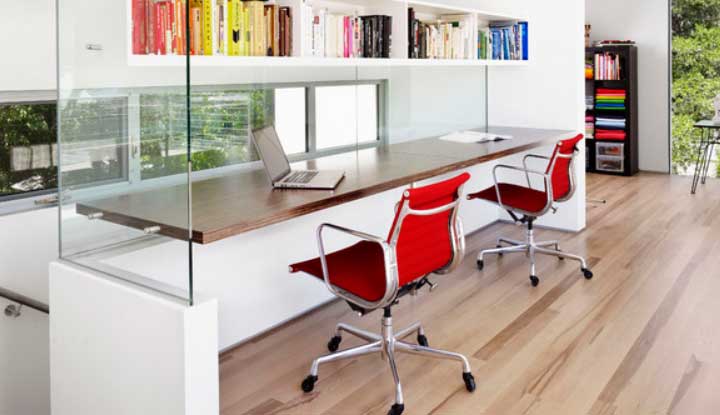Working from home definitely has its perks. However, it can often be a lot harder to concentrate because of various distractions in your home. To ensure continuous productivity, organizing your home office is an essential step.
So, here are ten quick tips to help you get started:
-
Find the perfect spot.
First things first. “Nomading” around the house to work (i.e., at the dining table, in your bedroom, or in the living room) won’t give you the best results. While they are relaxing, those types of environment aren’t conducive to productive work. There are too many distractions. Instead, opt for a suitable home office space that will solely serve as your home office. Choose a room or an area that’s furthest away from noise and interference. Also avoid bringing pleasurable distractions (e.g., televisions) into your space unless you need them for work.
-
Clean your desk.
Just like in a more formal office setting, you should definitely clear your home office desk from unnecessary things (i.e., piles of documents, food, boxes, and general clutter). Clutter can stress you out. As Lifehacker reports, “Whether it be your closet or office desk, excess things in your surroundings can have a negative impact on your ability to focus and process information. That’s exactly what neuroscientists at Princeton University found when they looked at people’s task performance in an organized versus disorganized environment. The results of the study showed that physical clutter in your surroundings competes for your attention, resulting in decreased performance and increased stress.” So, only keep things on your desk that are essential for work, such as your computer or laptop.
-
Invest in a file cabinet or organizational storage.
Unless you strive for a paperless office you are bound to have lots of documents that could be piling up on your desk or on the floor. However, unorganized files increases the risk of randomly losing or damaging them. So, invest in a file cabinet or organizational storage.
-
Empty your trash bin regularly.
Spring cleaning isn’t the only time you should empty your trash. If it is overflowing with crumpled paper and other materials, schedule a time each week for clean up. Few people would find inspiration to work in a dirty environment. Avoid this by regularly emptying your trash bin—say, every two or three days –to make room for your paper waste.
-
Manage your cables.
Visibly disorganized cords and cables are annoying — especially when they get tangled up. Aside from potentially tripping on them, it is also an eyesore. Keep your power cables from knotting together by using cord organizers. These are tools that take the form of a tube or a clip that bundles cords together. Also, unplug gadgets and appliances you don’t always use. This improves organization and will save you money on your electricity bill.
-
Create a reminder system.
Sticky notes are typically used for reminding people of certain tasks and errands. Whether you use paper notes, a notebook, or an app create a system that helps you keep track of new ideas. Ideas are fleeting and easy to lose track of during the course of a busy day. When you keep track of your thoughts, online or offline, you will save time and frustration trying to recall all of your ideas.
-
Utilize a calendar.
Having a visible calendar around your work area helps you manage your schedule better. Use a marker to cross out days when you are up against a deadline or counting down to your next important business meeting.
-
Install a wall clock.
Does time easily slip by while you’re in your home office? Constantly seeing what time it is will help you manage your time better. This is especially important when you’re doing tedious work since it would help you allot a specific time period when moving from one task to another.
-
Ensure adequate lighting.
Regardless of what task you’re completing in your home office, sufficient lighting is important. It’s best to opt for natural light whenever the situation permits. Human eyes were designed to work with the changing levels of sunlight; natural light reduces eye fatigue and lessens headaches. You can get more sun by situating your workstation where there are lots of windows and opening the curtains. If your home office is in the basement or other low light areas, opt for daylight bulbs since these imitate natural light.
-
Create a space for everything.
Do you find yourself searching for things? If so, you should ensure that you have a designated place for everything in your home office. According to Diane Albright, a certified professional organizer, “The average American wastes 55 minutes a day looking for things they know they have but can’t find,” Albright says. “If you add up those minutes in an eight hour day, they amount to six weeks [a year] of walking around just looking for things.” (Source: The Arts Institute)
Morrys Sarmiento is a web content writer whose main interests are online marketing, lifestyle, and business management. Among his interests outside the profession are football, music, theories of personality, philosophy, gaming, and creepy stories. Connect with @Morrysxi on Twitter.
© YFS Magazine. All Rights Reserved. Copying prohibited. All material is protected by U.S. and international copyright laws. Unauthorized reproduction or distribution of this material is prohibited. Sharing of this material under Attribution-NonCommercial-NoDerivatives 4.0 International terms, listed here, is permitted.







